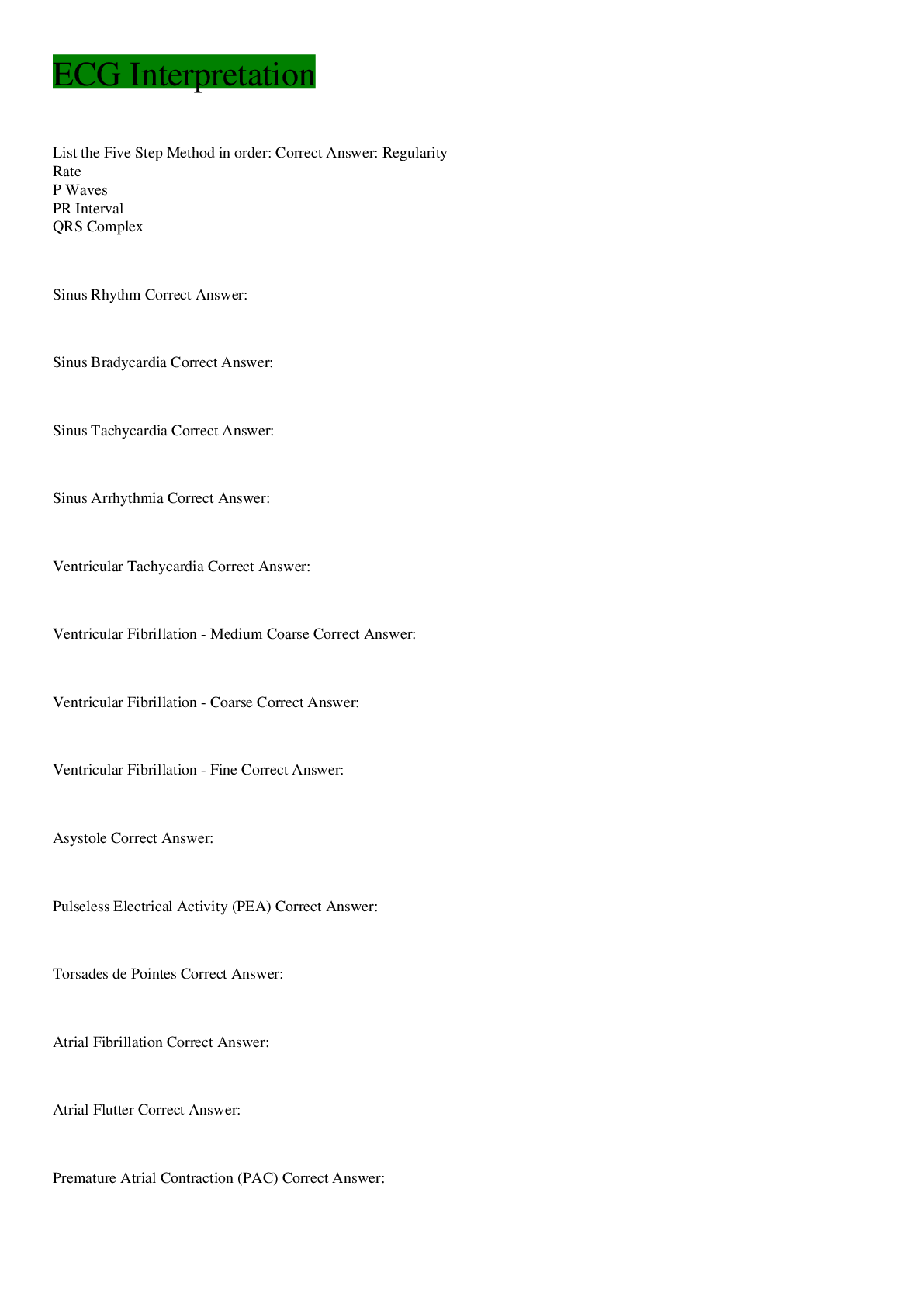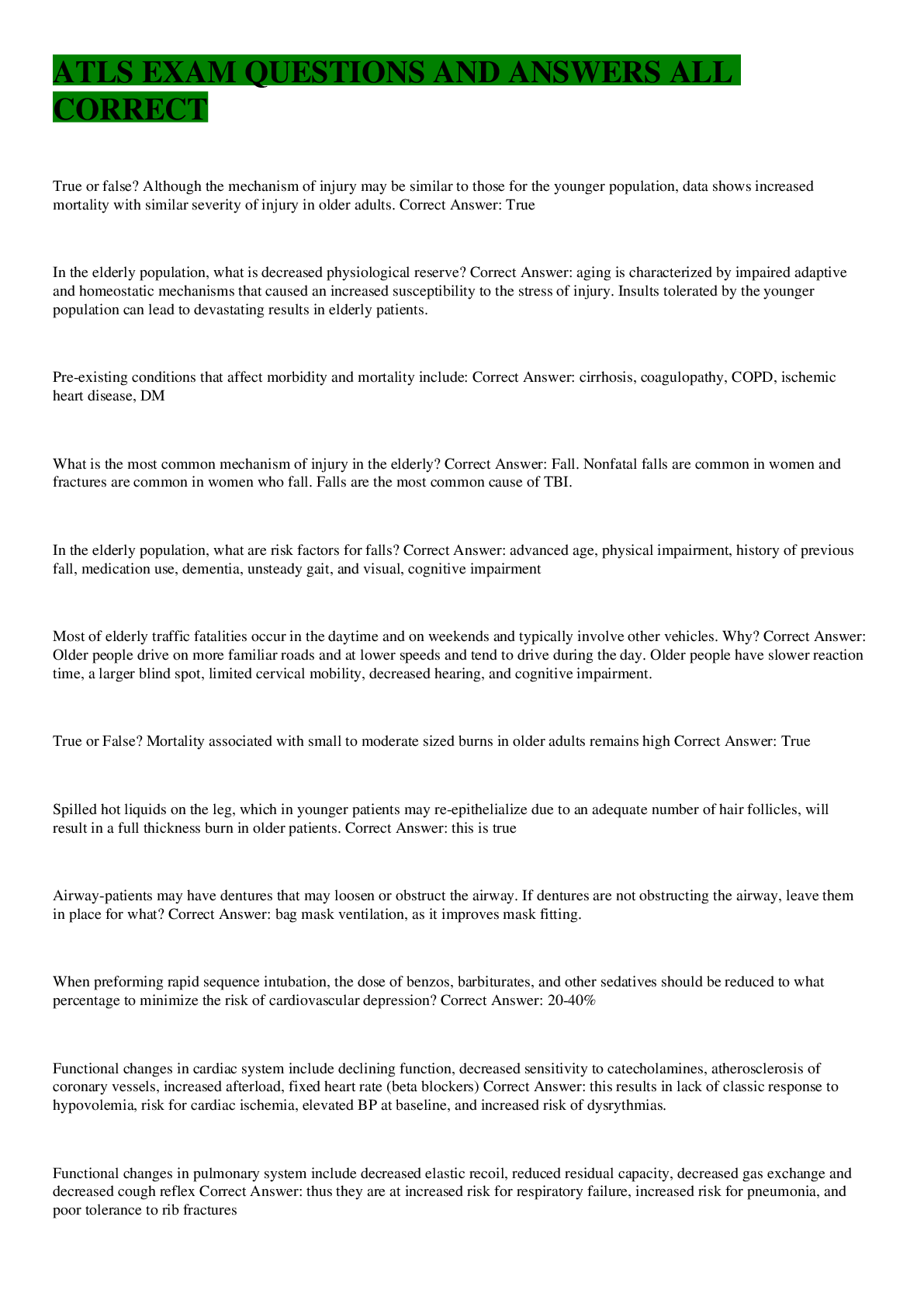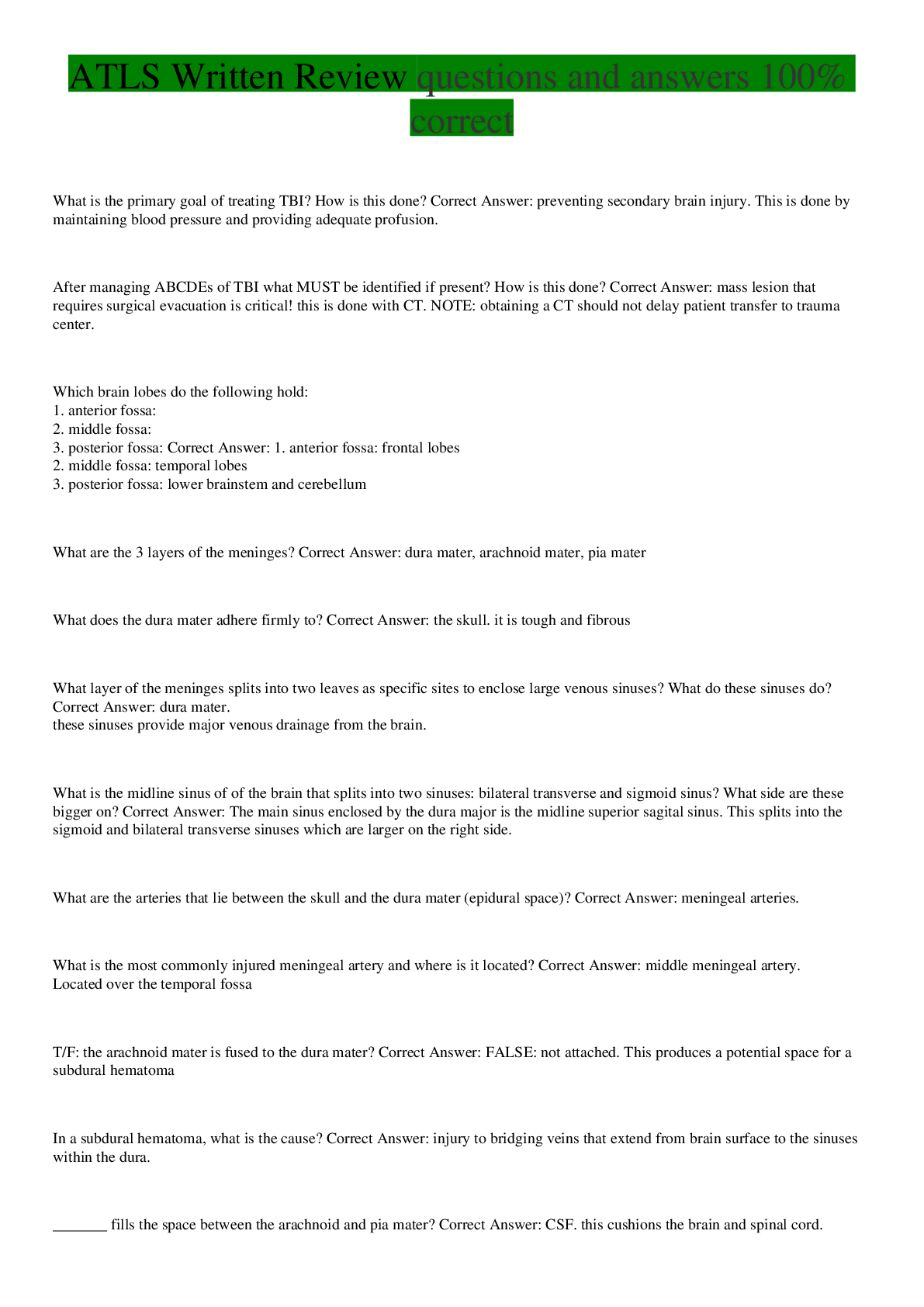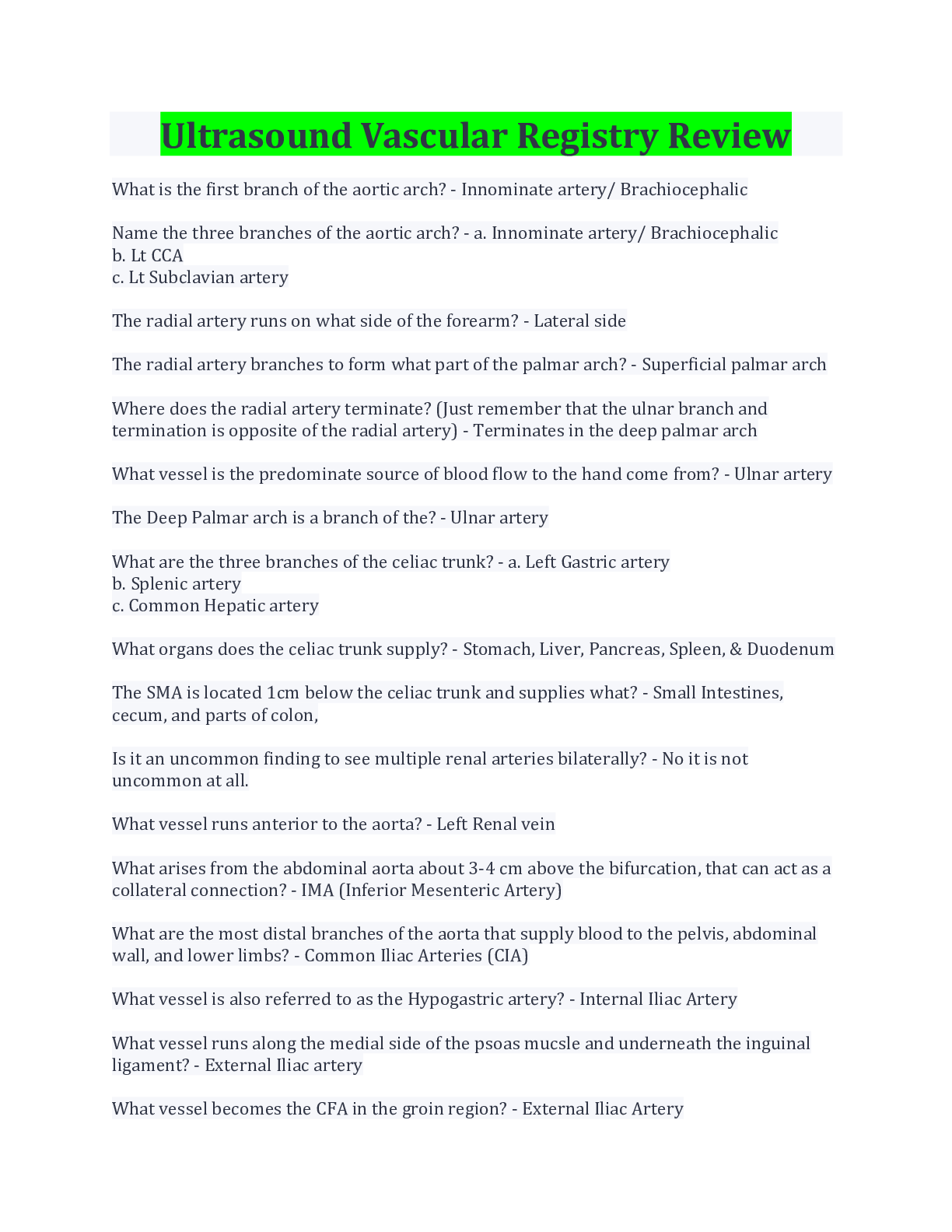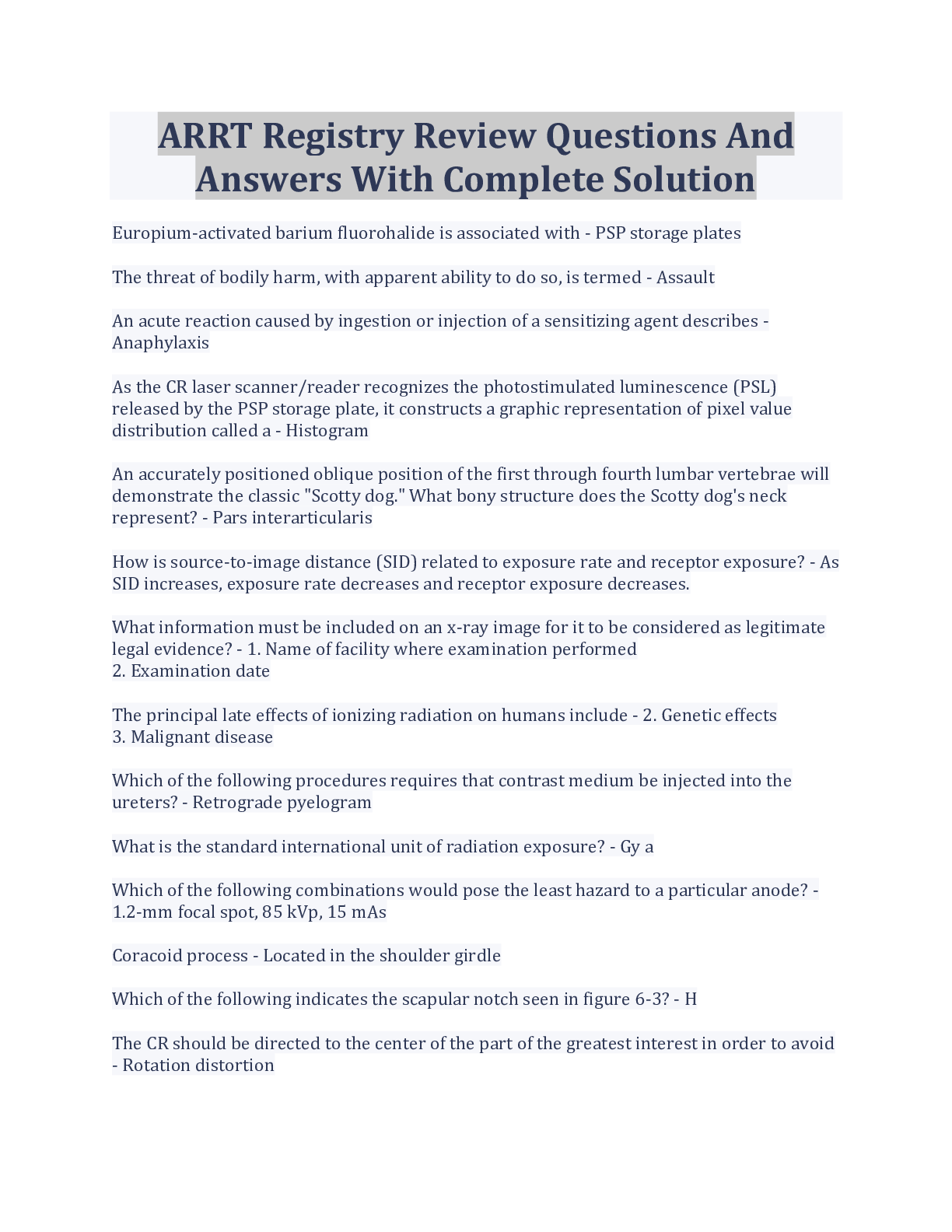Health Care > EXAM > Paramedic National Registry Review QUESTIONS AND ANSWERS (All)
Paramedic National Registry Review QUESTIONS AND ANSWERS
Document Content and Description Below
Morals are? Correct Answer: What a society deems is acceptable conduct of individuals; right and wrong. Ethics are? Correct Answer: What a profession deems is acceptable conduct and behavior. ... The components of a good patient assessment are? Correct Answer: 1. PPE. 2. Scene safety. 3. Location of all patients. 4. Mechanism of injury or Nature of illness. 5. Initial Assessment. 6. Focused history and physical exam. What is the appropriate PPE to use when treating a tuberculosis patient? Correct Answer: Place a surgical mask on the patient while wearing a NIOSH-approved respirator. A mechanism of injury is? Correct Answer: The combined strength, direction, and nature of forces that injured your patient. Who takes priority when determining scene safety? Correct Answer: 1. Yourself. 2. Your crew. 3. Other responding personnel. 4. Your patient. 5. Any bystanders. What is the purpose of the initial assessment? Correct Answer: To identify and immediately correct life-threats to the patient's airway, breathing, and circulation. What steps should be performed during an initial assessment? Correct Answer: 1. Form a general impression. 2. Stabilize the cervical spine. 3. Assess the baseline mental status. 4. Assess the airway. 5. Assess breathing. 6. Assess circulation. What is the purpose of the general impression? Correct Answer: To determine the general clinical status and priority for transport. What phrases do we use to categorize patients' metal status? Correct Answer: 1. Alert 2. Verbal 3. Painful stimuli 4. Unresponsive When can we assume that a patient's airway is patent? Correct Answer: When the patient is responsive and can speak clearly. When would an oropharyngeal airway be indicated? Correct Answer: An unconscious patient without a gag reflex. What characteristics should be evaluated in the most basic breathing assessment? Correct Answer: 1. Rate. 2. Quality. 3. Pattern. What comprises the most basic circulation assessment? Correct Answer: 1. Evaluate the pulse. 2. Evaluate the skin. 3. Control any hemorrhage. What are the four main types of patients? Correct Answer: 1. Responsive medical patients. 2. Unresponsive medical patients. 3. Trauma patients with an isolated injury. 4. Trauma patients with a significant mechanism of injury. What are some predictors of serious internal injury? Correct Answer: 1. Ejection from vehicle. 2. Death in the same passenger compartment. 3. A fall from higher than 20 feet. 4. Vehicle rollover. 5. High-speed motor vehicle collision. 6. Vehicle-passenger collision. 7. Motorcycle crash. 8. Penetrating injuries to the head or torso. What are some significant mechanisms of injury for infants and children? Correct Answer: 1. A fall from higher than ten feet. 2. A bicycle collision. 3. A medium-speed vehicle collision with resulting severe vehicle deformity. What is the purpose of a rapid trauma assessment? Correct Answer: To quickly and systematically assess for other life-threatening injuries. What does DCAP-BTLS stand for? Correct Answer: D = Deformities. C = Contusions. A = Abrasions. P = Punctures. B = Burns. T = Tenderness. L = Lacerations. S = Swelling. What makes up a focused history evaluation? Correct Answer: 1. Vital signs. 2. SAMPLE history. How would you define an "isolated-injury" trauma patient? Correct Answer: One with no significant mechanism of injury that shows no signs of systemic involvement. In what two ways does assessing a responsive medical patient differ from assessing a trauma patient? Correct Answer: 1. The history takes precedence over the physical exam. 2. The physical exam is aimed at identifying medical complications rather than signs of injury. What is the chief complaint? Correct Answer: It is the pain, discomfort, or dysfunction that caused the patient to call for help. What does OPQRSTU-ASPN stand for? Correct Answer: O = Onset. P = Provocation and palliation. Q = Quality. R = Region and radiation. S = Severity. T = Timing. U = You. AS = Associated Symptoms. PN = Pertinent Negatives. What mnemonic do we use to assess a patient's "history of present illness?" Correct Answer: OPQRSTU What should you ask about when discussing past medical history? Correct Answer: 1. General state of health. 2. Childhood and adult diseases. 3. Psychiatric illnesses. 4. Accidents and injuries. 5. Surgeries and hospitalizations. 6. Alcohol, tobacco, and substance use. 7. Diet, exercise, and leisure activities. 8. Immunizations. 9. Sleep patterns. What is the purpose of an ongoing assessment? Correct Answer: To detect trends and determine changes in the patient's condition. What should be evaluated during a basic ongoing assessment? Correct Answer: 1. Mental status. 2. Airway patency. 3. Breathing rate and quality. 4. Pulse rate and quality. 5. Skin condition. 6. Transport priority. 7. Vital signs. What should be evaluated during a basic focused assessment? Correct Answer: 1. Effects of interventions. 2. Management plans. 3. Re-evaluate ABC's. 4. Evaluate intervention effects. In what circumstances are you required to report misconduct to law enforcement? Correct Answer: 1. Spousal abuse. 2. Child abuse or neglect. 3. Elder abuse. 4. Sexual assault. 5. Gunshot or stab wounds. 6. Animal bites. 7. Communicable diseases. What is the purpose of the good samaritan laws? Correct Answer: They provide immunity to certain people who assist at the scene of a medical emergency. What is the purpose of the Ryan White CARE Act? Correct Answer: To provide notification and assistance to paramedics who have been exposed to certain diseases. What does it mean to be "accountable" as a paramedic? Correct Answer: It means that you will always exercise the same degree of care, skill, and judgement expected under like circumstances by a similarly trained, reasonable paramedic in the same community. What is negligence? Correct Answer: Deviation from accepted standards of care recognized by law for the protection of others against the unreasonable risk of harm. What are the components of a negligence claim? Correct Answer: 1. Duty to act. 2. Breach of duty. 3. Actual damages. 4. Proximate cause. What constitutes "duty to act" in a negligence claim? Correct Answer: A formal, contractual, or informational legal obligation to provide care. What constitutes a "breach of duty" in a negligence claim? Correct Answer: An action or inaction that violates the standard of care expected from a paramedic. What is malfeasance? Correct Answer: The performance of a wrongful or unlawful act by a paramedic. What is Misfeasa [Show More]
Last updated: 1 year ago
Preview 1 out of 36 pages
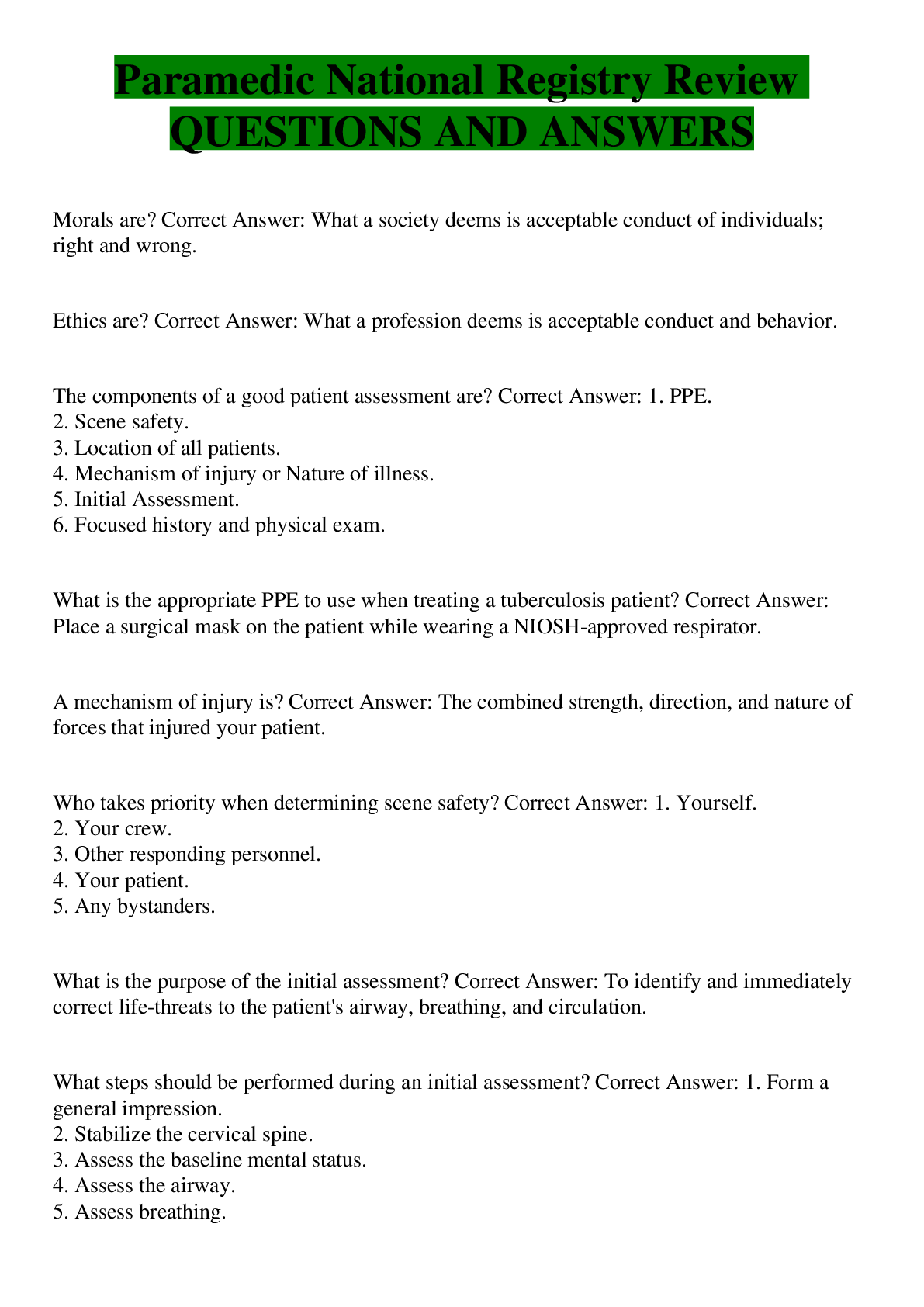
Buy this document to get the full access instantly
Instant Download Access after purchase
Add to cartInstant download
We Accept:

Reviews( 0 )
$13.00
Document information
Connected school, study & course
About the document
Uploaded On
Sep 12, 2022
Number of pages
36
Written in
Additional information
This document has been written for:
Uploaded
Sep 12, 2022
Downloads
1
Views
80




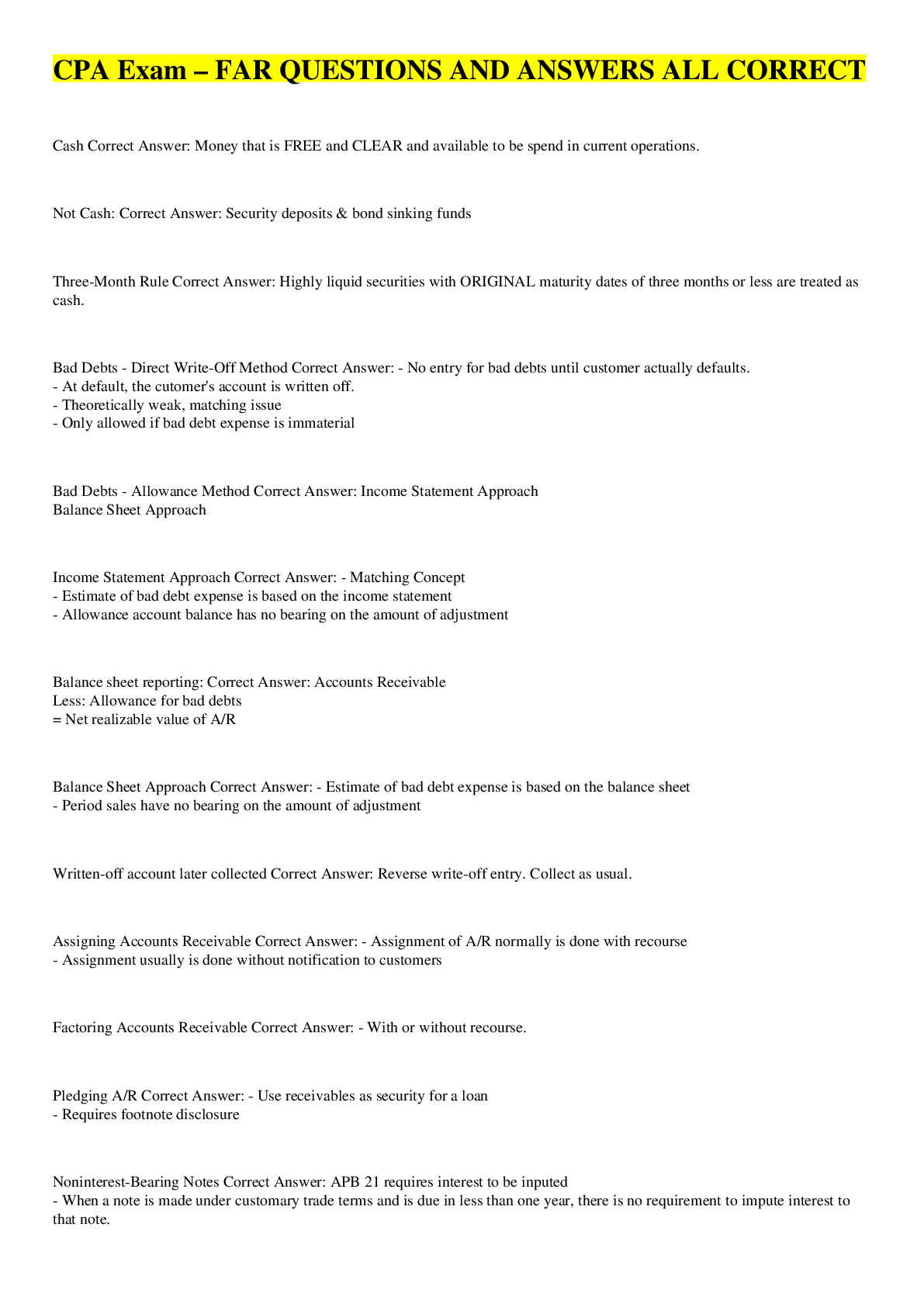
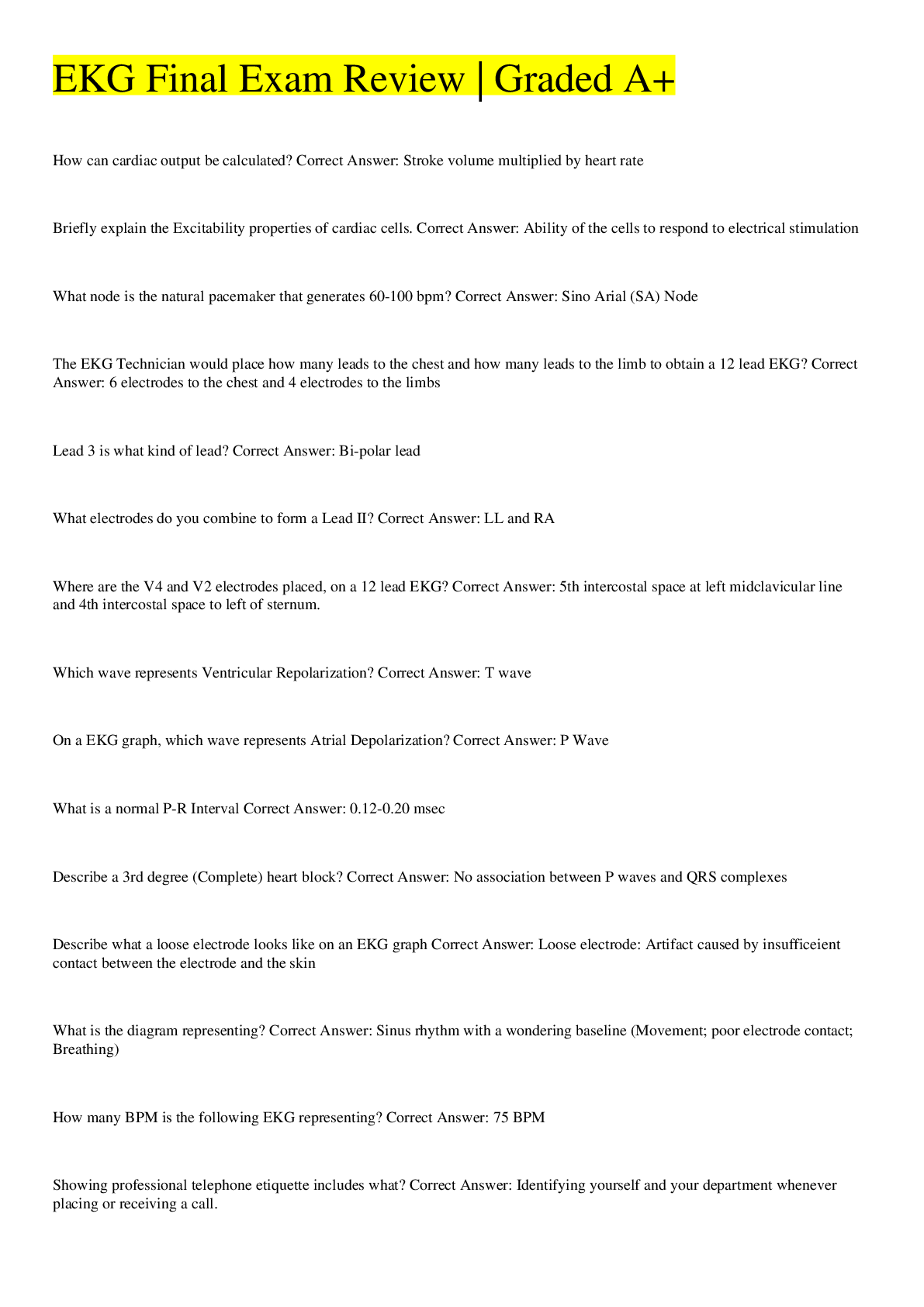

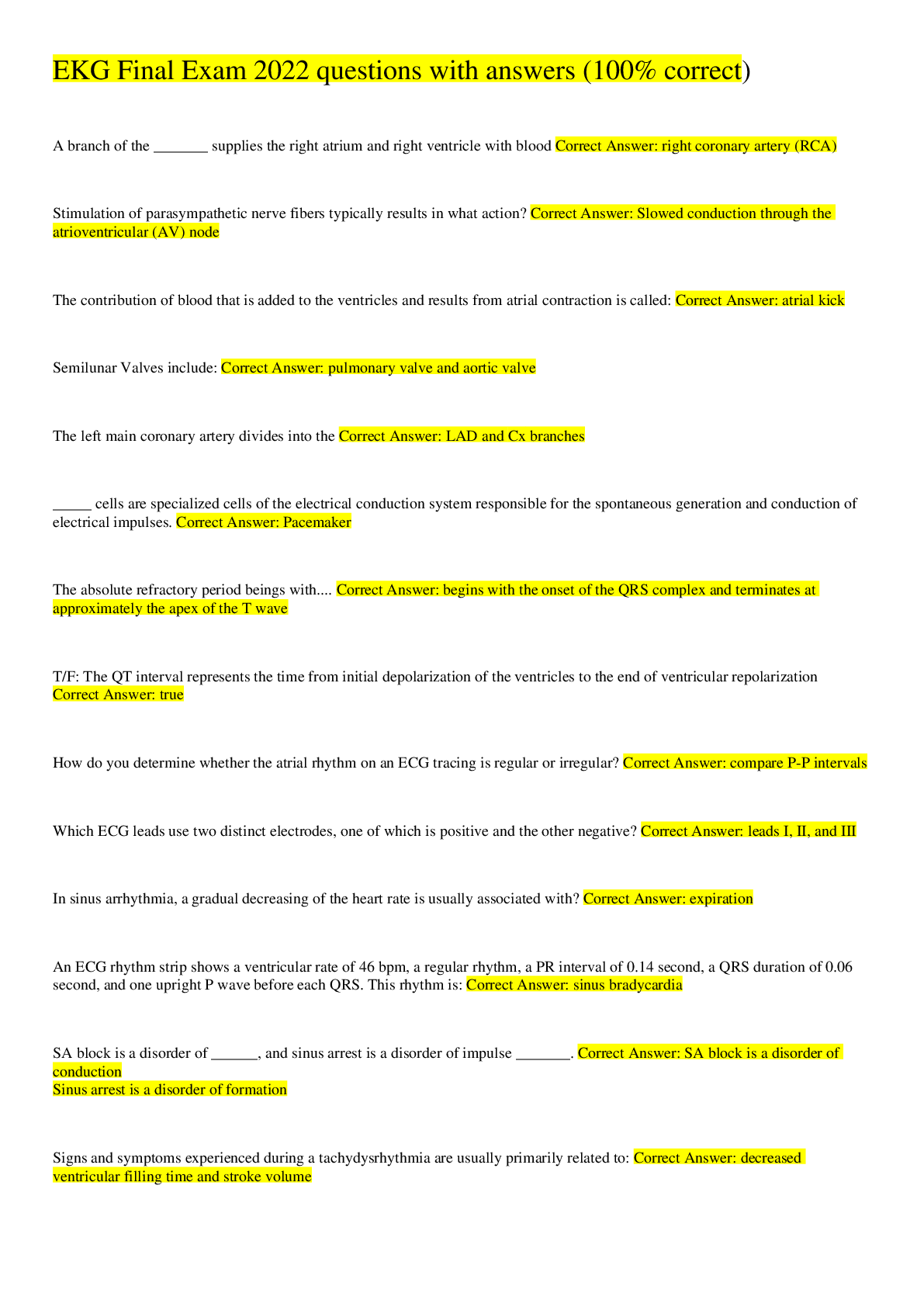
.png)
